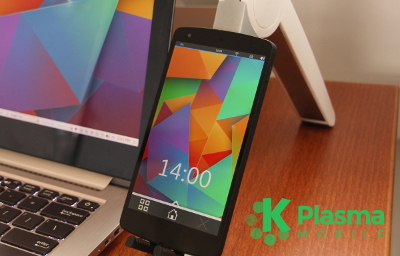
While Ubuntu Phone continues to stew, bereft of new devices and little developer interest, other efforts to create a fully-fledged Linux* smartphone are picking up pace.
Chief among them is KDE Plasma Mobile.
KDE itself needs little introduction. It’s one of the most popular Linux desktop environments around, and recently celebrated it’s 20th birthday.
Plasma is the name of its graphical user interface (GUI), and you’ll probably know it best in its desktop guise.
But KDE community has its sights set beyond the desktop. It has ambitions to run on a much broader set of devices, including tablets and, more interestingly, smartphones.
Plasma Mobile — An Android Alternative?
The mobile market desperately needs a 3rd player. Microsoft has all-but hanged up on Windows Phone, while Blackberry is a long way from its ripe days. Sailfish OS, spearheaded by Jolla, and Ubuntu for Phones, backed by Canonical, claim to be best placed, but remains minnows swimming up a tidal stream.
But why be a fish?
Something nimbler, something less focused on being a “mainstream” contender that ticks all the boxes of millennial focus groups, could be better placed to succeed.
And that’s where Plasma Mobile comes in.
Creating a new mobile platform for the high-volume, mass-market world is a thankless task. Android and iOS are dominant, and smartphone users too reliant on a mature app ecosystem to want to switch.
Sure, ‘Scopes free you from the app grid’ — but if everything you do on a phone relies on apps from an app grid, how is that a boon?!
Plasma Mobile seems to be taking a different approach, and it’s being touted as a way to turn your smartphone into a “fully open hacking device, just like a PC.” The aim is a create a truly customisable UI ‘built with modularity from the ground up’. Plasma Mobile also touts a heavy emphasis on user privacy.
Its vision statement is thus:
“Plasma Mobile aims to become a complete software system for mobile devices. It is designed to give privacy-aware users back the full-control over their information and communication. Plasma Mobile takes a pragmatic approach and is inclusive to 3rd party software, allowing the user to choose which applications and services to use. It provides a seamless experience across multiple devices. Plasma Mobile implements open standards and it is developed in a transparent process that is open for the community to participate in.”
ROMs, Not Device Raffles
Like Android’s insurgency, Plasma Mobile aims to be a hackable, flashable ROM for existing (popular) Android phones. It can even dual-boot with Android, and is able to run on both ARM and Intel-based devices.
Plasma Mobile uses tried-and-tested software stack, including: libhybris, KWin, Wayland, Voicecall, Ofono, Telepathy and Pulseaudio .
Lots of Apps
A capable smartphone, however dev-driven, need apps. Developers behind KDE’s mobile effort want to make sure that you can access and install an array of apps and add-ons, including native Plasma apps and widgets, some Ubuntu phone apps, and web apps. Support for native Sailfish and Nemo apps is also planned.
It doesn’t stop there, either.
To create a true “Phone as PC” experience the Plasma Mobile aims to allow you install and run regular Qt. GTK, and X11-based applications (via XWayland) on the OS.
How can you try it?
Plasma Mobile currently supports the Nexus 5 and the OnePlus One, as well as Intel-based devices.
You’ll need to be prepared for many limitations as Plasma Mobile is under development, and not aimed at end users.
But the device can do the essentials of a dumb phone, like make calls, send texts and snap photos, and a small set of apps are available.
For more information head over to the Plasma Mobile website. To get involved in porting, developing and shaping the OS head to the KDE Plasma Mobile forums.
